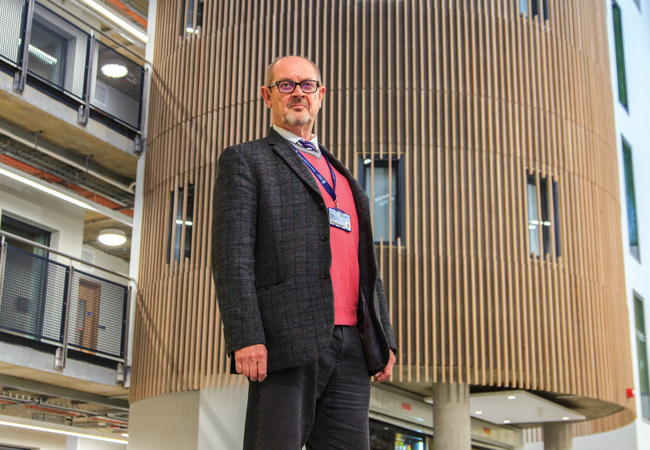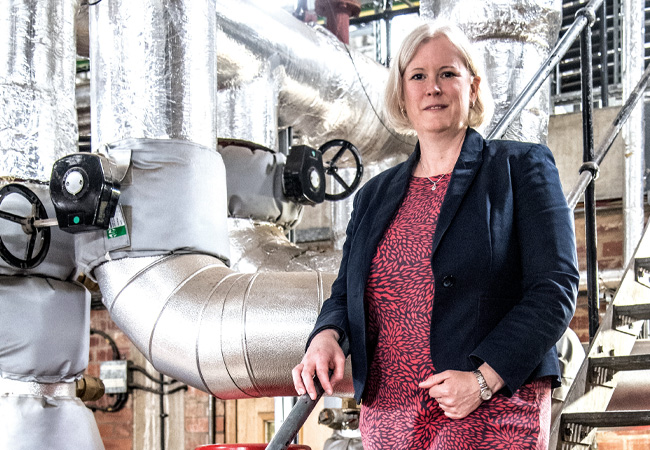
Jerry Shoolbred at the new science building at Anglia Ruskin University
The cost per year of a clerk of works is cheaper than a day in court. This quote, by barrister Tony Bingham, has never rung more true than it does today, says Jerry Shoolbred, who fulfills the role at Anglia Ruskin University.
The quality controller: How the clerk of works @AngliaRuskin university ensures building operation matches design intent #Build2Perfrom https://t.co/kwtYHafAeI pic.twitter.com/zWmtvvVcYK
— CIBSEJournal (@CIBSEJournal) February 5, 2018
He cites Dame Judith Hackitt’s interim report on building regulations and fire safety, Building a safer future. In it, respondents raise concerns about the prevalence of value engineering, and outline the need for the increasingly uncommon role of a clerk of works as an onsite quality control function.
‘I would like to think that, had one been employed at Grenfell, he or she would have made sure the materials were as the drawings and specification, and that the non-combustible cladding specified was the one that ended up being installed,’ says Shoolbred. ‘A clerk of works – or quality control officer – really adds value to a job.’
The role entails ensuring projects achieve value for money and are completed to a high standard in terms of workmanship, materials and construction.

Shoolbred keeps a site diary on all projects
Shoolbred liaises with mechanical, electrical and sustainability engineers to ensure services are installed correctly, and helps to protect the client’s interests throughout the construction process to get the project right first time. This is essential at a university that has campuses in Cambridge, Chelmsford, London and Peterborough. The Cambridge campus is home to one of only nine optometry schools in the UK while, in Chelmsford, the university has embarked on an ambitious programme of development, with the School of Medicine due to open in September.
Experience
Shoolbred has been a clerk of works for 40 years, and has worked at Anglia Ruskin University for the past 14.
Interestingly, he started his career in the same place in the 1970s, when he completed a carpenter and joiner apprenticeship at Cambridge College of Arts and Technology. This later joined forces with Chelmsford College, became Anglia Polytechnic and, eventually, Anglia Ruskin University. ‘It’s nice to come back and see how the place has changed,’ Shoolbred says.
As the university expands, every two years or so, he gets to work with a new set of contractors and consultants. ‘From every job we do, we pick up what we’ve learned – and what didn’t work – and take that through to the next job,’ says Shoolbred, whose experience means he can identify potential issues and suggest alternative methods or mitigation techniques.
“From every job we do, we pick up what we’ve learned – and what didn’t work – and take that through to the next job”
‘[Past Aston Martin owner] David Brown once said that racing improves the breed. That works here as well; every time we produce another building – or bring another on stream – we’ve learned from previous projects, so try to build better and sensibly,’ he says.
As clerk of works, Shoolbred follows a project from inception to decommissioning. ‘I see where the drainage and utilities go in at the front; I see the structure of the building go in; and I’m there at handover, dealing with defects,’ he says.
He also endeavours to get involved with new projects at the design stage. ‘I use my experience to give my professional opinion and make recommendations for alternative approaches – whether it’s the best choice of entrance mats or the preferred type of lights, and where things can go wrong.’
Quality control
Shoolbred ensures he sits in at the early stages of design, as a quality control element, so the university’s needs are embedded in the design. He has a focus on quality, promoting right-first-time initiatives, to help reduce rework and double-handling.
‘The clerk of works’ role is to read through all the drawings from the contractor, architects and consultant – as well as the specifications – and make sure the contractor isn’t taking any shortcuts,’ says Shoolbred.

A lecture theatre at the science building
‘You have to be very open with the contractor, who should be prepared to give you the agreed drawings and specifications upfront, as soon as possible.’
Towards the end of a particular trade package, Shoolbred produces a list of defects. ‘When I see something wrong, I’ll flag it up straight away, because construction times are so tight nowadays. We have to make sure it’s built properly, so we don’t have any long, drawn-out snagging lists at the end,’ he says.
Most of the projects at the university are procured through design and build, so Shoolbred tries to influence any derogations or value engineering. ‘I spend a lot of time trying to put back what is being stripped out [from the specification] – and that’s not always easy because I have to take into account quality, time and cost.
‘There have been many occasions [in my career] when I’ve been working on site and a particular handrail detail I expected to see has changed to a flimsy bit of string, because the cost managers have got in there and toned it down. I’ll then fight to make sure they put back the original.’
As a clerk of works, Shoolbred doesn’t have any budget of his own, and is entirely dependent on the major projects and the maintenance teams. ‘I’ll make recommendations as it suits and fits, while still having my site quality control hat on, so the client gets what they pay for,’ he says.
By looking at things from a maintenance angle, Shoolbred is able to bring a different perspective to the table. ‘Because our buildings are so well used – there might be classes from 8am to 9pm, for example – there’s very little downtime on any of them, so we have to include as many maintenance-free practicalities as we can.’
What is a clerk of works?
The Institute of Clerks of Works and Construction Inspectorate defines the role as a ‘person whose duty is to superintend the construction and maintenance of buildings, or other works, to ensure proper use of labour and materials’.
A clerk of works represents the interests of the client by ensuring the quality of materials and workmanship are in accordance with the specification and engineering drawings.
The job title is believed to derive from the 13th century, when monks and priests took on the responsibility of supervising works associated with building churches. As craftsmen and masons became more educated they took on the role. By the 19th century, it had expanded to cover the majority of building works.
Before the mid-1990s, most local authorities employed teams of clerks of works within the architects and engineering department. After the recession of the 90s, however, cutbacks resulted in professional services being outsourced to facilities management companies, and clerks of works were not replaced after retirement.
Their duties include:
- Inspecting buildings for safety and structural integrity
- Overseeing workmanship to minimise problems and rework
- Inspecting materials to ensure they are correct, suitable and of appropriate quality
- Checking for – and minimising – defects
- Giving recommendations to the client throughout construction
Recording and reporting
As well as the university’s commissioning engineers, CML – which regularly reports any defects to the clerk of works – Shoolbred says the university relies on its maintenance department. These experienced mechanical, electrical and sustainability engineers work alongside the contracted teams during every project. ‘They’ve been around – they know what works and what doesn’t work – so they have an input throughout,’ he says.
The department has regular projects and M&E liaison meetings, with all the project building officers, clerk of works and maintenance engineers in attendance, to ensure information is readily and easily shared. ‘Sometimes talking saves no end of emails,’ says Shoolbred.

Shoolbred stays on a project throughout the 12-month defects period
To make sure nothing is missed when services go on site, Shoolbred keeps a site diary. ‘More importantly, I take loads of photographs – of things in ducts, in cupboards and under the ground, and of connections into the building,’ he says. ‘That way, I have a record of it – because, sooner or later, it will be lost within risers, which will be lost within floors.
‘I want to make sure I’ve seen that it’s been put in properly and that it hasn’t been damaged before going in. Otherwise, the contractor has to come back to put things right, which might mean further downtime.’
Before handover, Shoolbred ensures the maintenance team familiarises itself with the building.
‘We’ll arrange a series of training days with the contractor and subcontractors,’ he says. ‘There’s nothing like listening to what a technician is telling you, so you can hammer them with questions.’
Every contractor must also provide an asset list – a building information model that includes every item, from air handling units to filters and pumps, which are all asset tagged. Like the old planned preventative maintenance chart, this list includes information on every mechanical and electrical element within the building, including the model number, cost, when it is expected to fail, and how much use it is likely to get.
‘This gives you an idea of when an asset might go wrong, so you can include the cost of replacing it in your budget,’ says Shoolbred. ‘We can work with our maintenance colleagues to plan ahead, ensuring our engineers and contractors are there to look after various building services.’
Essential on site

Roof-mounted PV panels at the science building
Shoolbred believes saving money is the main reason the clerk of works role has all but disappeared. ‘There’s no doubt that having a clerk of works on site makes a difference,’ he says.
‘They have the experience of seeing a project at the front, all the way through to the end. They know what’s gone into the ground, and they can hand it over to their clients and do the aftercare – as I do at the university. I stay on a project throughout the 12-month defects period and do the coordination and liaison, so clients know there’s a face they can come to if there’s a problem.’
Shoolbred believes clerks of works would not only save clients money, but would help ensure projects are delivered with safety in mind. They have the ability to anticipate, interpret, record, advise and help reduce risk, while providing guidance on health and safety, he says.
If a client employed a clerk of works, they would have fewer problems down the line, he adds, because they are impartial, with a fair and independent approach to ensuring value for money for the client.
‘But, mostly,’ says Shoolbred, ‘a clerk of works reports the facts.’




